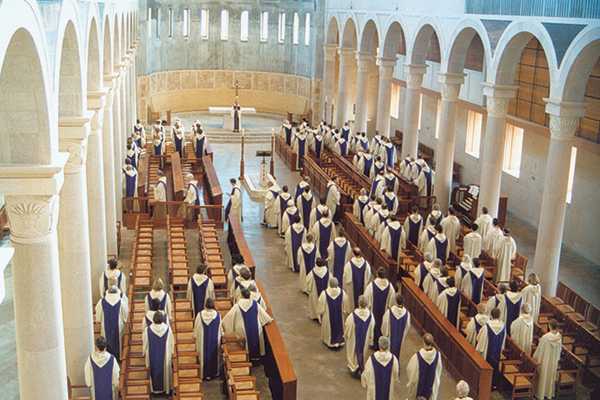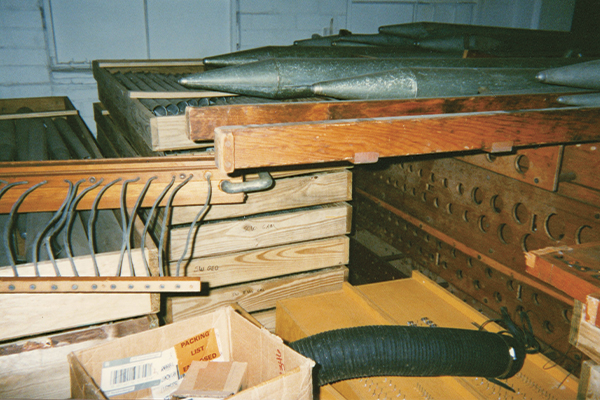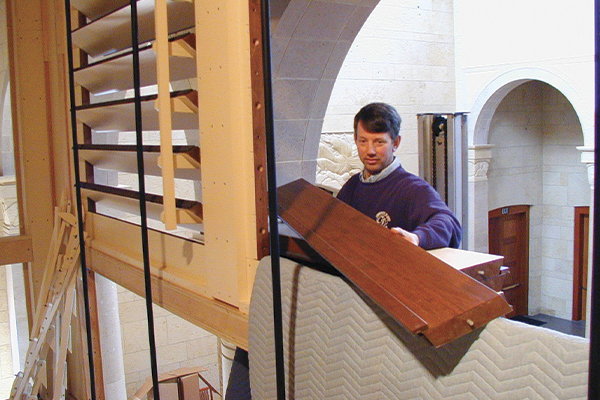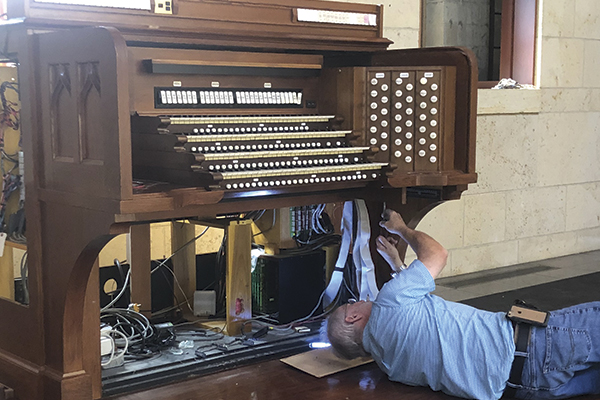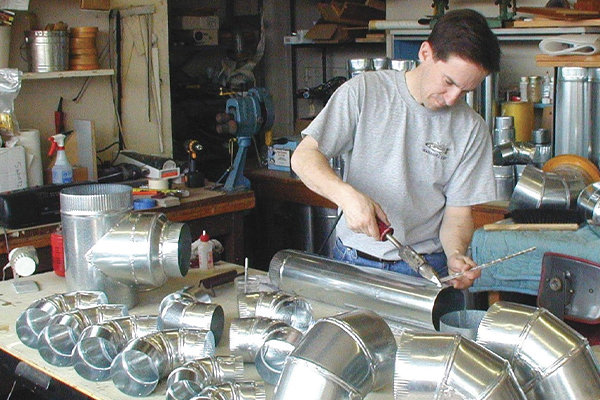The History of the Organ
To that end, the organ’s specification, geographic layout, and overall design were inspired and motivated by the ministry and mission of Gloriæ Dei Cantores (the resident professional choir at the Community of Jesus) as well as the community’s enthusiastic hymn singing. Gloriæ Dei Cantores performs repertoire of more than thirty nationalities, from Gregorian chant to music of the present day—a challenge for any organ to support, given the number of genres this includes!
Before meeting Nelson, we had committed to the restoration of an E. M. Skinner organ for the Church of the Transfiguration, knowing the innate beauty and flexibility of these instruments. In fact, we had already purchased, and had in storage, Skinner Organ Company Opus 762 from the Munn Avenue Presbyterian Church in East Orange, New Jersey. We soon realized, however, that this instrument would not be enough on its own and instead would need to become the basis for something far larger and with greater impact. In order to fulfill his vision and charge to unite the organ with the basilica form of the church, Nelson said, “Surround Sound:”
For this installation, I suggest rotating the traditional east-west organ placement 90 degrees to north-south and stretching the instrument completely down the nave in balconies over both side aisles. The divisions would start near the chancel (above the choir seating) with the Swell and Choir on opposite sides. These would be followed by an exposed Great and an Enclosed Great (including some Pedal) to broaden the tone and bring it down the nave . . . . Next would be matching north and south Solo divisions, followed by North and South Orchestral. These paired divisions would contain similar but distinct voices. These four matched divisions would form the “moving melody” section. . . . Near the west end would be the Bombarde/Antiphonal opposite the Echo. The shades of these divisions would not open directly toward the congregation but project the sound toward the back wall. This would modulate the heavy hitters in the Bombarde and allow the Echo to do a tonal “disappearing act.” The directional and surround effects achieved by computer control of stops and shades would lift the instrument beyond state-of-the-art into a unique realm. Moving melody could range freely over the building from left to right and front to back . . . . A single pianissimo chord from the chancel could grow into a mighty wave of sound, roll down the entire length of the nave, cascade into the Echo, and disappear.
Over the course of many years, there ensued hundreds of discussions about the numerous specifics needed to arrive at such a conclusion. (The specification alone has been through more than 150 revisions!) Only two weeks after the first fax came the next “prophetic” fax that would soon reveal the platform upon which we would collaborate for more than two and a half decades.
- Encourage apprentice-interested Community of Jesus members into the organ building field to act as good stewards in both the construction and future care of this instrument; and
- Let the project take the time required for the organ to “teach and tell us” how it should grow and be transformed through varied experiences.
- World-class and unique
- Ideally suited to your purposes
- A tangible expression of Community of Jesus spiritual principles
- Beautiful and musical, with instantly recognizable tone
- Designed for posterity; built to last forever
- Able to perform both nineteenth-century music authentically and eighteenth-century Bach convincingly
- Capable of eliciting profound emotions
- Designed for HDCD recordings
- Focused on future developments, not current technology
- A “trend setter.”
- Adopting the vision
- Making the commitment to move forward
- Incorporating the organ space into the church design
- Refining the vision, shaping it to our precise needs
- Defining the mechanical system of the organ
- Developing a plan of action and a realistic budget
- Locating a shop and storage space
- Beginning to implement the plan of action
- Training part-time workers and develop their expertise
- Acquiring more component parts to restore
- Organizing and commencing restoration work
- Setting up a division and playing it for inspiration!
Thus, the organ restoration project began in earnest.
The disposition of the divisions is as follows:
Disposition:
| APSE | |
| CHOIR | SWELL |
| NORTH GREAT (AND PEDAL) | SOUTH GREAT (AND PEDAL) |
| SOLO (AND PEDAL) | STRING (AND PEDAL) |
| ANTIPHONAL/PROCESSIONAL | ECHO |
| WEST END | |
Opus 140, Trinity Episcopal Cathedral, Cleveland, Ohio
Opus 195, Williams College, Williamstown, Massachusetts
Opus 310, Plymouth Church, Shaker Heights, Ohio
Opus 473, Florida State University, Tallahassee, Florida
Opus 540, Saint Paul’s Lutheran Church, Williamsport, Pennsylvania
Opus 541, First Congregational Church, St. Petersburg, Florida
Opus 655, Saint Paul’s Episcopal Church, Rochester, New York
Opus 656, Princeton University, Princeton, New Jersey
Opus 762, Munn Avenue Presbyterian Church, East Orange, New Jersey
Opus 855, Sacred Heart Catholic Church, Pittsburgh, Pennsylvania
Opus 858, Rollins College, Winter Park, Florida
Opus 934, Saint Joseph’s College, Adrian, Michigan
Opus 991, Broadway Tabernacle, New York, New York
Opus 1242, First Baptist Church, Abilene, Texas
June 2000: Dedication of the Church of the Transfiguration: North Great, Swell, and Tuba Mirabilis
June 2003: Great Artist series begins with American Guild of Organists Regions I and II convention, featuring Thomas Murray: Choir division
June 2005: Fifth anniversary of the Church of the Transfiguration: Antiphonal/Processional divisions
June 2010: Tenth anniversary of the Church of the Transfiguration: Echo division and arrival of the West End console for the concerts by Gerre and Judith Hancock and Thomas Murray
Summer 2018: 32′ Bombarde installed on South side
Summer 2019: removal of 1929 console and return of the rewired west end console serving as temporary main console
February 2020: Arrival of the final console
Our new console was designed, constructed, and installed by Richard Houghten and Joseph Zamberlan. From 2000 until 2020, we had used the original Skinner Organ Company console from Opus 762, which by 2020 the organ had long outgrown. The new console was designed to be as comfortable as a Skinner one, with everything clearly identified and within reach. Special features include shade expression thumb slides underneath the bottom three keyboards, an expression matrix so that any of the divisions can be assigned to a specific swell shoe (the entire organ is under expression), ivory keyboards that came from the Opus 762 console and are E. M. Skinner’s “tracker touch.” Some unusual couplers such as pedal to manual are included.
Perhaps the most moving realizations are the visionary outlooks of how this organ would affect people as they listened and experienced it in the setting of the Church of the Transfiguration. In concluding his initial thoughts to us in May 1995, Nelson wrote this to encourage us to take this on:
The Ultimate Goal
Every church is an expression of the builders, and so is every organ. When this instrument is finished, Community members will feel they are a part of the organ, and the organ is part of them. It will give voice to their aspirations and resonate with deep-seated meaning.
Building a magnificent instrument is hard work, sometimes tedious and always prolonged. Non-professionals may become discouraged, just as organ builders are when the job drags on. The difference is that organ builders hold a vision that gives them boundless energy and faith. They know the end result and imagine how it sounds.
Community members will understand everything when their labor comes to life and the organ starts to play. Lumber and leather, wire, and wind—if a pipe organ can sing with the angels, isn’t there hope for us all?
Mother Betty Pugsley
Nelson Barden
Sean O’Donnell
Joseph Sloan
Joseph Rotella
John Ananda
Jonathon Ambrosino
Duane Prill
William Czelusniak
Richard Houghten
Joseph Zamberlan
Christopher Broome
David Broome*
James Hudson Crissman
Peter Rudewicz
Thomas Murray
David Craighead*
Gerre Hancock*
*deceased
To learn more, please visit our website, www.communityofjesus.org.
—Nelson Barden and Jim Jordan
Since 1956, Nelson Barden has been recognized as one of America’s leading experts in the museum quality restoration of orchestral pipe organs—particularly the work of E. M. Skinner—and is President of Nelson Barden & Associates.
Jim Jordan is one of the organists in residence at the Church of the Transfiguration at the Community of Jesus since 1988, during which has performed as an organ accompanist for Gloriæ Dei Cantores, and a soloist throughout the United States and Eastern and Western Europe.
